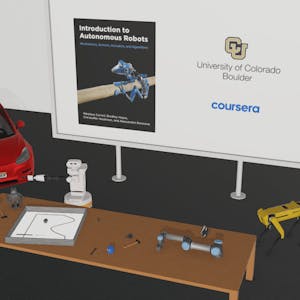The Introduction to Robotics with Webots specialization offers comprehensive learning in the design and control of intelligent robotic systems. Through a series of modules, you will delve into forward and inverse kinematics, trajectory planning, and uncertainty management in robotic sensing and actuation.
Throughout the program, you will gain hands-on experience using Python and the Webots simulator to implement robotic behaviors, map trajectories, and execute complex tasks. The course is designed to provide a deep understanding of mechanisms, sensors, and control, enabling you to develop the skills necessary for a career in robotics.
Certificate Available ✔
Get Started / More Info
The Introduction to Robotics with Webots course is divided into three modules that cover topics such as basic robotic behaviors and odometry, robotic mapping and trajectory generation, and robotic path planning and task execution. Each module provides hands-on experience and theoretical knowledge essential for understanding robotic systems.
Module 1: Basic Robotic Behaviors and Odometry
Module 2: Robotic Mapping and Trajectory Generation
Module 3: Robotic Path Planning and Task Execution
IBM Applied DevOps Engineering is a comprehensive program by IBM, equipping professionals with the latest DevOps practices and technologies. Gain hands-on experience...
Getting Started with Generative AI APIs provides an introduction to OpenAI's GPT-3 and guides learners in creating programs powered by the GPT model.
Professionalize your SQL query writing and performance tuning skills in this guided project. Improve query execution time and apply indexing and join strategies...